NVIDIA's GeForce GTX 465: Cheaper Isn’t Always Better
by Ryan Smith on May 31, 2010 3:26 AM ESTPower, Temperature, & Noise
In our GTX 480 review, we identified both the GTX 480 and GTX 470 as being abnormally hot & loud. Perhaps with the reduction in functional units and a lower memory clock speed NVIDIA will be able to bring this in to check? Let’s find out.
Or not.
Let’s first start with core voltage. For the GTX 400 series NVIDIA does not use a single voltage for each card, instead they assign voltage on a per-chip basis. So while there are trends we can look at, there is no absolute single voltage as we’ve seen on past cards. The following is the load voltage on each of our sample cards.
| GeForce GTX 400 Series Load Voltage | |||
| GTX 480 | GTX 470 | GTX 465 | |
| Load Voltage |
0.959v
|
0.962v | 1.025v |
In terms of core voltage the GTX 465 ends up being a notable outlier. Our GTX 480 and 470 samples have a load core voltage of 0.959v and 0.962v respectively according to GPU-Z, while our GTX 465 from Zotec is a good 0.04v higher at 1.025v. This is only a 4% increase in core voltage overall, but as GF100 has an idle voltage of .875v, this means it takes a 50% greater voltage increase over idle to bring our GTX 465 to load compared to our GTX 470.
NVIDIA is dealing with some very tight thermal and power requirements on the GTX 480 and 470 – getting a 3 billion transistor chip to not run amok drawing power is hard work. From this we can infer that NVIDIA is not only holding back chips with damaged functional units, but also chips that run but just take too much voltage (and ultimately power) to do so. With fewer functional units, the GTX 465 has a greater tolerance for high-voltage chips and it looks like this is where NVIDIA is sending some of them as a result. This is why there’s only a 15W TDP difference between the two cards: NVIDIA “spent” their savings getting lesser GF100 GPUs in to products. So going by voltage alone, it’s clear that we’re not going to see the GTX 465 receive a huge benefit in terms of power, temperature, & noise.
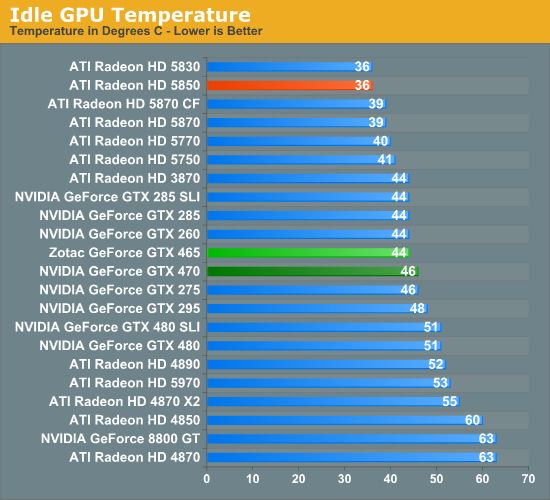
Moving on to our charts, we’ll start with idle temperatures. Even with the same idle voltage and same cooler as the GTX 470, the GTX 465 delivers a slight surprise: it ends up idling at 2C under the GTX 470. This puts it squarely in the same territory as the GTX 200 series.
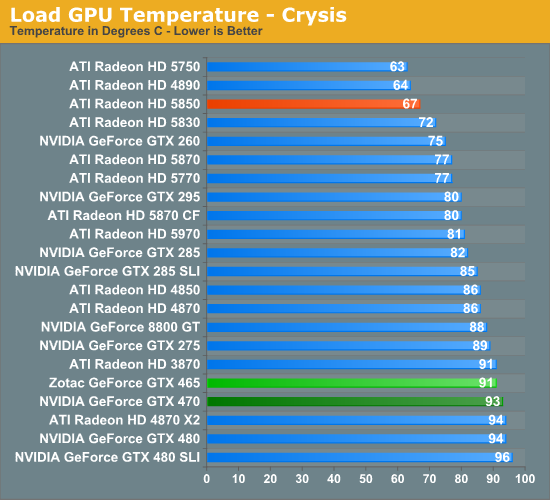
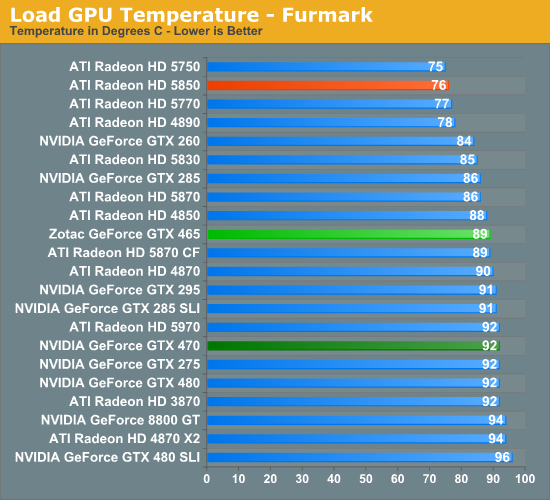
Moving on to load temperatures, we can begin to see the price of using a GPU with a higher core voltage. Under Crysis that 2C advantage over the GTX 470 holds, with temperatures peaking at just 91C. This still makes it the 3rd hottest single-GPU card we have tested, tieing with the Radeon HD 3870 and coming in 24C hotter than the 5850, a card it underperforms in this game.
FurMark has a similar showing, with the GTX 465 coming in 3C cooler than the GTX 470. Overall things are better for the GTX 465 here though, as it’s better than roughly half of our cards here, placing amongst the Radeon HD 4890, 4850, and only a hair above the 5870 and GTX 285. Even the gap between the GTX 465 and 5850 drops quite a bit, with only 13C separating the two.

Next we have idle power consumption, measuring the total power consumption of our GPU testbench. While NVIDIA didn’t give the GTX 465 an official idle power draw, we’re measuring it at 1W less than the GTX 470. The GTX 470 was rated for 33W, so it’s safe to say the GTX 465 is close to that. It’s quite likely that the difference comes down to the savings from running 2 fewer GDDR5 RAM chips.
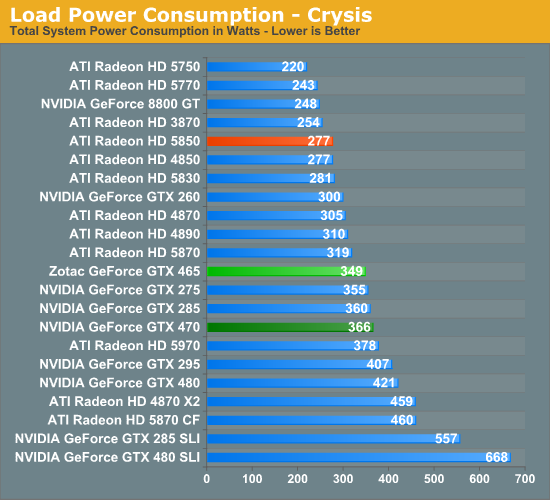
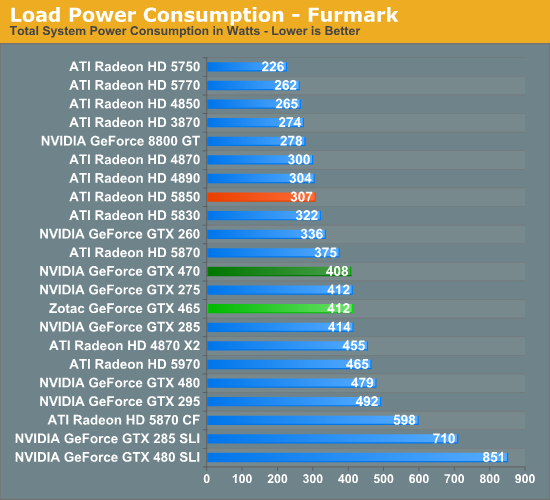
As for load power draw, having seen our temperature results the actual power figures should not be a surprise. Under Crysis the GTX 465 has more in common with the GTX 470 than the power-saving Radeon HD 5000 series, drawing 17W less than the GTX 470 and 72W more than the 5850. Based on our voltage numbers from earlier and this data, it’s clear that NVIDIA had to give up a lot of power savings to make this specific GPU operate.
Meanwhile under FurMark we see those savings evaporate in to nothingness. Here the GTX 465 actually surpasses the GTX 470 by 4W, coming in at 412W versus 408W. At this point it’s drawing as much power as a GTX 275/285, and 105W more than the Radeon 5850. We did not expect the GTX 465 to end up drawing more power than the GTX 470 here, as the 2 fewer RAM chips should have offset the difference. Looking at just the GPU, there’s a good chance the GPU in our GTX 465 card is drawing more power than the GTX 470 under most situations.
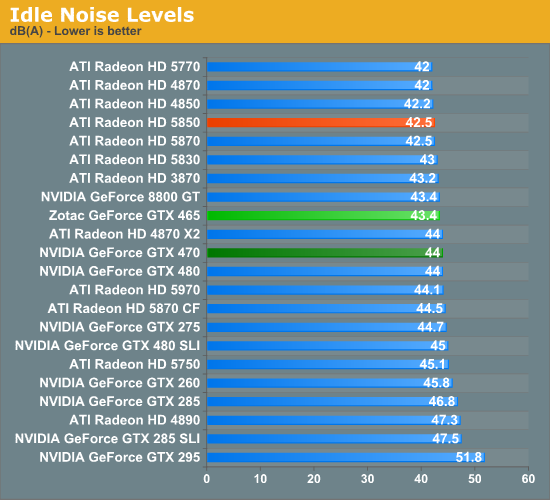
Last but not least we have our noise testing. As the GTX 465 uses the same cooler as the GTX 470, the results should be very close and our idle noise measurements deliver on that. Our GTX 465 idles at 43.4db(A), effectively tied with the GTX 470 and only marginally different than most of the rest of our cards.
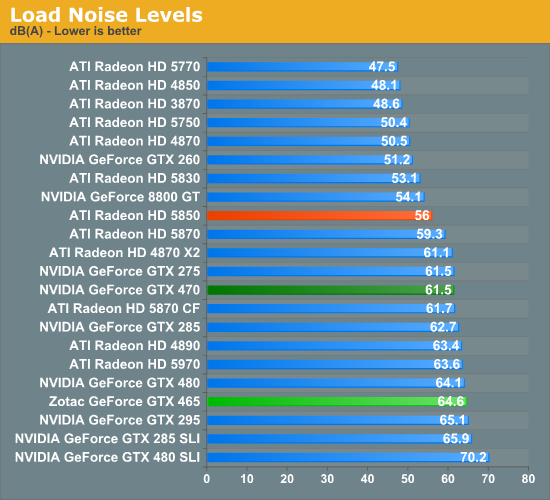
When we first did our load noise testing on our GTX 465, we thought something was wrong. It sounded louder than the GTX 480 or GTX 470, and when we put a sound meter to it the results reflected that. But after triple-checking our results there’s nothing wrong with our data – the GTX 465 really is louder than the GTX 470 and the GTX 480. As fan speeds are tied to the GPU temperature we’re looking at the culprit being the fan profile used for the GTX 465, as the hardware is identical to the GTX 470. It looks like NVIDIA tweaked the GTX 465 to be a bit more aggressive than the GTX 470, which in turn makes this the likely reason why we’ve measured the GTX 465 as being cooler than the GTX 470 in spite of their similar power draw.
Our best guess here is that with the GTX 465’s higher operating voltage, NVIDIA wanted a slightly lower operating temperature to compensate. As with any other case where we’ve only measured a single card there’s the possibility of a great deal of variation, but what we’ve seen makes sense. Across the entire spectrum of GTX 465 and GTX 470 cards it’s reasonable to assume this data is correct and that the GTX 465 is on average a couple of db(A) louder than the GTX 470.
It goes without saying that this isn’t a reasonable amount of noise for the performance the card delivers. The Radeon HD 5870 is 5dB(A) quieter, and the 5850 extends than to 8dB(A) quieter. At these noise levels 8dB(A) is a very noticeable difference.










71 Comments
View All Comments
multivac - Monday, May 31, 2010 - link
also, you thanked Zotec at the endrscsr - Monday, May 31, 2010 - link
I read earlier the GTX465 review at computerbase.de and the load temperatures and power are well of both GTX 465 are well below the GTX 470.could it be that there is something wrong with your GTX 465 or your GTX 470 has a particular low power draw?
Ryan Smith - Monday, May 31, 2010 - link
It's always possible.The primary issue is that the quality of chips coming off of a wafer are going to be variable in the best of times, and TSMC's situation is not quite that good. So between any two cards there can be a lot of variability, which is hard to account for when we only have a handful of any given card.
I do not believe that our GTX 465 is "damaged" in any way. It functions just fine. But it consumes a lot of power, and it's hot. We may have simply received a card with a poorer-than-average GPU, which would color our results.
As for our GTX 470, looking at some of the other reviews of it, I don't believe it's particularly exceptional.
For anyone curious, under FurMark the fan on our 470 stabilizes at 76%. On the GTX 465 it stabilizes as 80%. This is the primary reason why our GTX 465 is louder than our 470.
CPUGuy - Monday, May 31, 2010 - link
"I read earlier the GTX465 review at computerbase.de and the load temperatures and power are well of both GTX 465 are well below the GTX 470.could it be that there is something wrong with your GTX 465 or your GTX 470 has a particular low power draw?"
Perhaps they were given a different sample card? Ever thought of that? You folks have to remember that these are not retail cards.
CPUGuy - Monday, May 31, 2010 - link
Why are you taking another review into consideration when they may have been given a different sample? I honestly don't think they had a retail version.MrSpadge - Monday, May 31, 2010 - link
It's said somewhere in the article that nVidia is using different voltages for these chips. So there you have it: Anand tested one at the upper bound of the voltage range (a worse chip) whereas computerbase likely got one which was more in line with the voltage on the 470/480s.Yes, voltage can make such a difference in power draw.
tviceman - Monday, May 31, 2010 - link
This review is sloppy and outright laughable at points. Although you state which Nvidia drivers used (3 of them) you clearly used different drivers and/or old benchmarks for the same game on many parts of the tests, despite the 257 drivers offering some noticeable across-the-board increases. Even if not by much, FPS scores should be slightly different and/or up. In some reviews, it was clear newer drivers were only used on certain cards as the gtx470 is way faster than the gtx480 at BFBC2. Nearly all the other benchmarks, though, have both cards scoring the exact same as they did at release.It's not an accurate, or credible, way to post a review. All tests should be done on the same configuration. same software, same hardware, same drivers. If you don't have time to rerun your gtx470/480 benchmarks with the latest drivers, then you should NOT include them in the review.
tviceman - Monday, May 31, 2010 - link
And just to say, it's not that I disagree with your analysis on the gtx465, but if you are going to have huge graphs showing how all the cards perform and where they fit vs. their counterparts and rivals, those graphs need to be accurate and not using different configurations that will skew results.Ryan Smith - Monday, May 31, 2010 - link
New drivers are always a thorny issue. In an ideal world I'd like to update our results with the latest drivers as they're released. But realistically it's 1-1.5 man-weeks of work to redo the entire benchmark suite and that's just not practical.As a result, for the most part we will keep the same results set for upwards of 6 months. If there's a significant change in performance due to a new driver we'll go ahead and rerun some numbers as necessary, which we have done for the 257.15 drivers. We will probably redo some more benchmarks, but it wasn't possible to get anything else done ahead of this review.
tviceman - Monday, May 31, 2010 - link
Well I think it's only fair, proper, and balanced to run all the cards with the same configuration. If you're unable to do so in the time frame alloted, then only include the cards which are in immediate competition and add more later.The BFBC2 benchmark looks plain WRONG with the gtx470 trouncing the gtx480. And since other gtx470 scores were exactly the same as your original review, it just looks like you randomly picked a few small benchmarks to update with the latest drivers, and left the rest untouched.
It just isn't accurate.